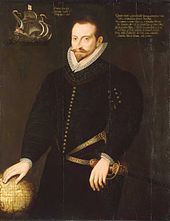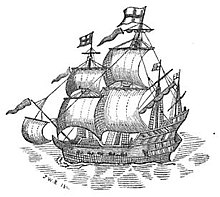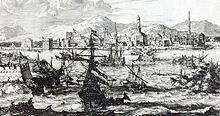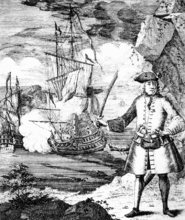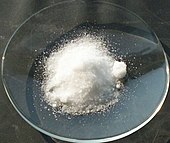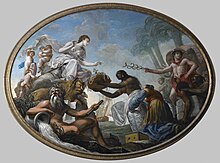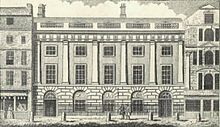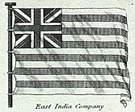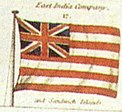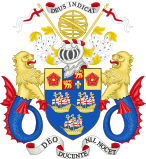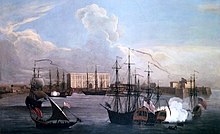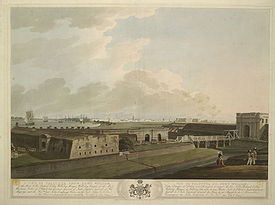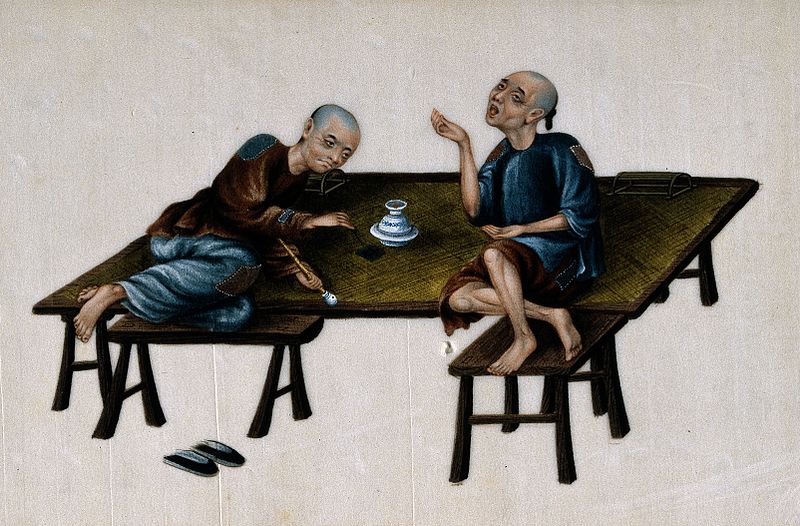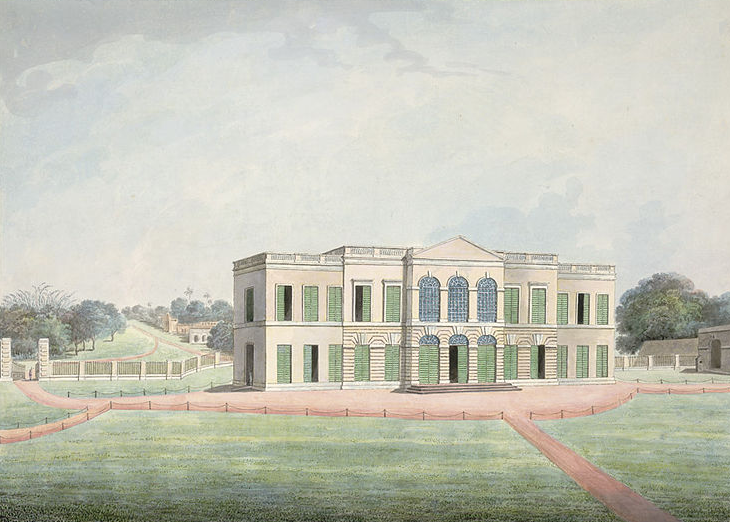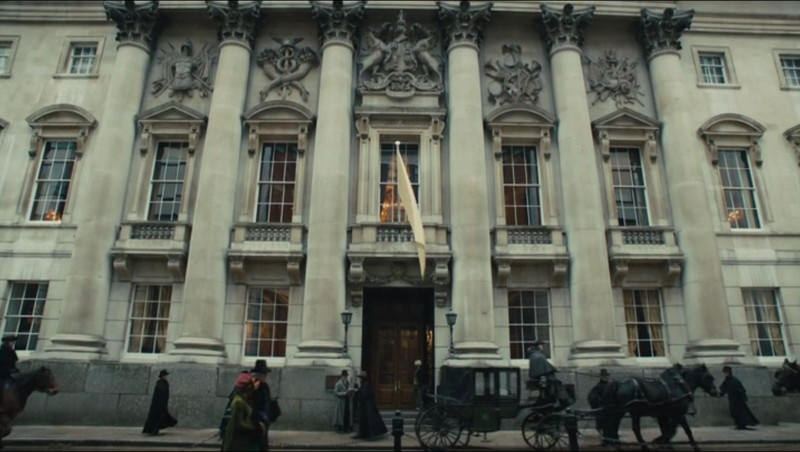This article is about the British East India Company. For the chartered East India Companies of other countries, see East India Company (disambiguation).
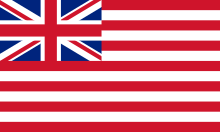
Company flag (1801) |
|
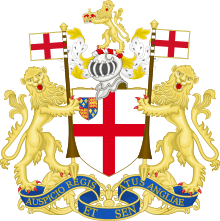
Coat of arms (1698) Motto: Auspicio Regis et Senatus Angliae |
|
| Type | Public State-owned enterprise[1] |
|---|---|
| Industry | International trade |
| Founded | 31 December 1600; 422 years ago |
| Founders |
|
| Defunct | 1 June 1874; 148 years ago |
| Fate | Nationalised:
|
| Headquarters | East India House,
London , Great Britain |
| Products | Cotton, silk, indigo dye, sugar, salt, spices, saltpetre, tea, slave trade and opium |
|
|
This article is missing information about the opium war. Please expand the article to include this information. Further details may exist on the talk page. (March 2023) |
The East India Company (EIC)[a] was an English, and later British, joint-stock company founded in 1600[b] and dissolved in 1874.[4] It was formed to trade in the Indian Ocean region, initially with the East Indies (the Indian subcontinent and Southeast Asia), and later with East Asia. The company seized control of large parts of the Indian subcontinent, colonised parts of Southeast Asia and Hong Kong. At its peak, the company was the largest corporation in the world.[vague] The EIC had its own armed forces in the form of the company’s three Presidency armies, totalling about 260,000 soldiers, twice the size of the British army at the time.[5][6] The operations of the company had a profound effect on the global balance of trade, almost single-handedly[7] reversing the trend of eastward drain of Western bullion, seen since Roman times.[8]
Originally chartered as the «Governor and Company of Merchants of London Trading into the East-Indies»,[9][10] the company rose to account for half of the world’s trade during the mid-1700s and early 1800s,[11] particularly in basic commodities including cotton, silk, indigo dye, sugar, salt, spices, saltpetre, tea, and opium. The company also ruled the beginnings of the British Empire in India.[11][12]
The company eventually came to rule large areas of India, exercising military power and assuming administrative functions. Company rule in India effectively began in 1757 after the Battle of Plassey and lasted until 1858. Following the Indian Rebellion of 1857, the Government of India Act 1858 led to the British Crown assuming direct control of India in the form of the new British Raj.
Despite frequent government intervention, the company had recurring problems with its finances. The company was dissolved in 1874 as a result of the East India Stock Dividend Redemption Act enacted one year earlier, as the Government of India Act had by then rendered it vestigial, powerless, and obsolete. The official government machinery of the British Raj had assumed its governmental functions and absorbed its armies.
Origins[edit]
In 1577, Francis Drake set out on an expedition from England to plunder Spanish settlements in South America in search of gold and silver. Sailing in the Golden Hind he achieved this, and then sailed across the Pacific Ocean in 1579, known then only to the Spanish and Portuguese. Drake eventually sailed into the East Indies and came across the Moluccas, also known as the Spice Islands, and met Sultan Babullah. In exchange for linen, gold and silver, a large haul of exotic spices including cloves and nutmeg were obtained – the English initially not realising their huge value.[13] Drake returned to England in 1580 and became a hero; his circumnavigation raised an enormous amount of money for England’s coffers, and investors received a return of some 5,000 percent. Thus started an important element in the eastern design during the late sixteenth century.[14]
Soon after the defeat of the Spanish Armada in 1588, the captured Spanish and Portuguese ships and cargoes enabled English voyagers to travel the globe in search of riches.[15] London merchants presented a petition to Queen Elizabeth I for permission to sail to the Indian Ocean.[16] The aim was to deliver a decisive blow to the Spanish and Portuguese monopoly of far-eastern trade.[17] Elizabeth granted her permission and on 10 April 1591, James Lancaster in the Bonaventure with two other ships, financed by the Levant Company[18] sailed from Torbay around the Cape of Good Hope to the Arabian Sea, becoming the first successful English expedition to India[18] via the Cape.[7]: 5 Having sailed around Cape Comorin to the Malay Peninsula, they preyed on Spanish and Portuguese ships there before returning to England in 1594.[16]
The biggest prize that galvanised English trade was the seizure of a large Portuguese carrack, the Madre de Deus, by Sir Walter Raleigh and the Earl of Cumberland at the Battle of Flores on 13 August 1592.[19] When she was brought in to Dartmouth she was the largest vessel ever seen in England and she carried chests of jewels, pearls, gold, silver coins, ambergris, cloth, tapestries, pepper, cloves, cinnamon, nutmeg, benjamin (a tree that produces frankincense), red dye, cochineal and ebony.[20] Equally valuable was the ship’s rutter (mariner’s handbook) containing vital information on the China, India, and Japan trade routes.[19]
In 1596, three more English ships sailed east but all were lost at sea.[16] A year later however saw the arrival of Ralph Fitch, an adventurer merchant who, with his companions, had made a remarkable fifteen-year overland journey to Mesopotamia, the Persian Gulf, the Indian Ocean, India and Southeast Asia.[21] Fitch was consulted on Indian affairs and gave even more valuable information to Lancaster.[22]
Formation[edit]
In 1599, a group of prominent merchants and explorers met to discuss a potential East Indies venture under a royal charter. Besides Fitch and Lancaster,[7]: 5 the group included Stephen Soame, then Lord Mayor of London; Thomas Smythe, a powerful London politician and administrator, whose father had established the Levant Company; Sir John Wolstenholme; Richard Hakluyt, writer and apologist for British colonization of the Americas; and several other sea-farers who had served with Drake and Raleigh.[7]: 1–2
On 22 September, the group stated their intention «to venture in the pretended voyage to the East Indies (the which it may please the Lord to prosper)» and to themselves invest £30,133 (over £4,000,000 in today’s money).[23][24] Two days later, the «Adventurers» reconvened and resolved to apply to the Queen for support of the project.[24] Although their first attempt had not been completely successful, they sought the Queen’s unofficial approval to continue. They bought ships for the venture and increased their investment to £68,373.
They convened again a year later, on 31 December 1600, and this time they succeeded; the Queen, responded favourably to a petition by «George, Earl of Cumberland and 218 others,[25] including James Lancaster, Sir John Harte, Sir John Spencer (both of whom had been Lord Mayor of London), the adventurer Edward Michelborne, the nobleman William Cavendish and other Aldermen and citizens.[26] She granted her charter to their corporation named Governor and Company of Merchants of London trading into the East Indies.[16] For a period of fifteen years, the charter awarded the company a monopoly[27] on English trade with all countries east of the Cape of Good Hope and west of the Straits of Magellan.[28] Any traders there without a licence from the company were liable to forfeiture of their ships and cargo (half of which would go to the Crown and half to the company), as well as imprisonment at the «royal pleasure».[29]
The charter named Thomas Smythe as the first governor[26]: 3 of the company, and 24 directors (including James Lancaster)[26]: 4 or «committees», who made up a Court of Directors. They, in turn, reported to a Court of Proprietors, who appointed them. Ten committees reported to the Court of Directors. By tradition, business was initially transacted at the Nags Head Inn, opposite St Botolph’s church in Bishopsgate, before moving to India House in Leadenhall Street.[30]
Early voyages to the East Indies[edit]
Sir James Lancaster commanded the first East India Company voyage in 1601 aboard Red Dragon.[31] The following year whilst sailing in the Malacca Straits Lancaster took the rich 1,200 ton Portuguese carrack Sao Thome carrying pepper and spices. The booty enabled the voyagers to set up two «factories» – one at Bantam on Java and another in the Moluccas (Spice Islands) before leaving.[32] They returned to England in 1603 to learn of Elizabeth’s death but Lancaster was knighted by the new king, James I on account of the voyage’s success.[33] By this time, the war with Spain had ended but the company had profitably breached the Spanish-Portuguese duopoly; new horizons opened for the English.[17]
In March 1604, Sir Henry Middleton commanded the second voyage. General William Keeling, a captain during the second voyage, led the third voyage aboard Red Dragon from 1607 to 1610 along with Hector under Captain William Hawkins and Consent under Captain David Middleton.[34]
Early in 1608 Alexander Sharpeigh was made captain of the company’s Ascension, and general or commander of the fourth voyage. Thereafter two ships, Ascension and Union (captained by Richard Rowles) sailed from Woolwich on 14 March 1608.[34] This expedition would be lost.[35]
| Year | Vessels | Total Invested £ | Bullion sent £ | Goods sent £ | Ships & Provisions £ | Notes |
|---|---|---|---|---|---|---|
| 1603 | 3 | 60,450 | 11,160 | 1,142 | 48,140 | |
| 1606 | 3 | 58,500 | 17,600 | 7,280 | 28,620 | |
| 1607 | 2 | 38,000 | 15,000 | 3,400 | 14,600 | Vessels lost |
| 1608 | 1 | 13,700 | 6,000 | 1,700 | 6,000 | |
| 1609 | 3 | 82,000 | 28,500 | 21,300 | 32,000 | |
| 1610 | 4 | 71,581 | 19,200 | 10,081 | 42,500 | |
| 1611 | 4 | 76,355 | 17,675 | 10,000 | 48,700 | |
| 1612 | 1 | 7,200 | 1,250 | 650 | 5,300 | |
| 1613 | 8 | 272,544 | 18,810 | 12,446 | ||
| 1614 | 8 | 13,942 | 23,000 | |||
| 1615 | 6 | 26,660 | 26,065 | |||
| 1616 | 7 | 52,087 | 16,506 |
Initially, the company struggled in the spice trade because of competition from the well-established Dutch East India Company. The English company opened a factory in Bantam on Java on its first voyage, and imports of pepper from Java remained an important part of the company’s trade for twenty years. The Bantam factory closed in 1683.
The emperor Jahangir investing a courtier with a robe of honour, watched by Sir Thomas Roe, English ambassador to the court of Jahangir at Agra from 1615 to 1618, and others
English traders frequently fought their Dutch and Portuguese counterparts in the Indian Ocean. The company achieved a major victory over the Portuguese in the Battle of Swally in 1612, at Suvali in Surat. The company decided to explore the feasibility of a foothold in mainland India, with official sanction from both Britain and the Mughal Empire, and requested that the Crown launch a diplomatic mission.[36]
Foothold in India[edit]
Company ships docked at Surat in Gujarat in 1608.[37] The company established its first Indian factory in 1608 at Surat,[37] and its second in 1616 at Masulipatnam on the Andhra Coast of the Bay of Bengal. The high profits reported by the company after landing in India initially prompted James I to grant subsidiary licences to other trading companies in England. However, in 1609 he renewed the East India Company’s charter for an indefinite period, with the proviso that its privileges would be annulled if trade was unprofitable for three consecutive years.
In 1615, James I instructed Sir Thomas Roe to visit the Mughal Emperor Nur-ud-din Salim Jahangir (r. 1605–1627) to arrange for a commercial treaty that would give the company exclusive rights to reside and establish factories in Surat and other areas. In return, the company offered to provide the Emperor with goods and rarities from the European market. This mission was highly successful, and Jahangir sent a letter to James through Sir Thomas Roe:[36]
Upon which assurance of your royal love I have given my general command to all the kingdoms and ports of my dominions to receive all the merchants of the English nation as the subjects of my friend; that in what place soever they choose to live, they may have free liberty without any restraint; and at what port soever they shall arrive, that neither Portugal nor any other shall dare to molest their quiet; and in what city soever they shall have residence, I have commanded all my governors and captains to give them freedom answerable to their own desires; to sell, buy, and to transport into their country at their pleasure.
For confirmation of our love and friendship, I desire your Majesty to command your merchants to bring in their ships of all sorts of rarities and rich goods fit for my palace; and that you be pleased to send me your royal letters by every opportunity, that I may rejoice in your health and prosperous affairs; that our friendship may be interchanged and eternal.— Nuruddin Salim Jahangir, Letter to James I.
Expansion[edit]
The company, which benefited from the imperial patronage, soon expanded its commercial trading operations. It eclipsed the Portuguese Estado da Índia, which had established bases in Goa, Chittagong, and Bombay – Portugal later ceded Bombay to England as part of the dowry of Catherine of Braganza on her marriage to King Charles II. The East India Company also launched a joint attack with the Dutch United East India Company (VOC) on Portuguese and Spanish ships off the coast of China that helped secure EIC ports in China,[38] independently attacking the Portuguese in the Persian Gulf Residencies primarily for political reasons.[39] The company established trading posts in Surat (1619) and Madras (1639).[40] By 1647, the company had 23 factories and settlements in India, and 90 employees.[41] The Crown turned Bombay over to the company in 1668, and the company established a presence in Calcutta in 1690.[40] The major factories became the walled forts of Fort William in Bengal, Fort St George in Madras, and Bombay Castle.
In 1634, the Mughal emperor Shah Jahan extended his hospitality to the English traders to the region of Bengal,[42] and in 1717 customs duties were completely waived for the English in Bengal. The company’s mainstay businesses were by then cotton, silk, indigo dye, saltpetre, and tea. The Dutch were aggressive competitors and had meanwhile expanded their monopoly of the spice trade in the Straits of Malacca by ousting the Portuguese in 1640–1641. With reduced Portuguese and Spanish influence in the region, the EIC and VOC entered a period of intense competition, resulting in the Anglo-Dutch Wars of the 17th and 18th centuries.
Within the first two decades of the 17th century, the Dutch East India Company or Vereenigde Oostindische Compagnie, (VOC) was the wealthiest commercial operation in the world with 50,000 employees worldwide and a private fleet of 200 ships. It specialised in the spice trade and gave its shareholders 40% annual dividend.[43]
The British East India Company was fiercely competitive with the Dutch and French throughout the 17th and 18th centuries over spices from the Spice Islands. Some spices, at the time, could only be found on these islands, such as nutmeg and cloves; and they could bring profits as high as 400 percent from one voyage.[44]
The tension was so high between the Dutch and the British East Indies Trading Companies that it escalated into at least four Anglo-Dutch Wars:[44] 1652–1654, 1665–1667, 1672–1674 and 1780–1784.
Competition arose in 1635 when Charles I granted a trading licence to Sir William Courteen, which permitted the rival Courteen association to trade with the east at any location in which the EIC had no presence.[45]
In an act aimed at strengthening the power of the EIC, King Charles II granted the EIC (in a series of five acts around 1670) the rights to autonomous territorial acquisitions, to mint money, to command fortresses and troops and form alliances, to make war and peace, and to exercise both civil and criminal jurisdiction over the acquired areas.[46]
In 1689 a Mughal fleet commanded by Sidi Yaqub attacked Bombay. After a year of resistance the EIC surrendered in 1690, and the company sent envoys to Aurangzeb’s camp to plead for a pardon. The company’s envoys had to prostrate themselves before the emperor, pay a large indemnity, and promise better behaviour in the future. The emperor withdrew his troops, and the company subsequently re-established itself in Bombay and set up a new base in Calcutta.[47]
| Years | EIC | VOC | France | EdI | Denmark | Total | ||||
|---|---|---|---|---|---|---|---|---|---|---|
| Bengal | Madras | Bombay | Surat | EIC (total) | VOC (total) | |||||
| 1665–1669 | 7,041 | 37,078 | 95,558 | 139,677 | 126,572 | 266,249 | ||||
| 1670–1674 | 46,510 | 169,052 | 294,959 | 510,521 | 257,918 | 768,439 | ||||
| 1675–1679 | 66,764 | 193,303 | 309,480 | 569,547 | 127,459 | 697,006 | ||||
| 1680–1684 | 107,669 | 408,032 | 452,083 | 967,784 | 283,456 | 1,251,240 | ||||
| 1685–1689 | 169,595 | 244,065 | 200,766 | 614,426 | 316,167 | 930,593 | ||||
| 1690–1694 | 59,390 | 23,011 | 89,486 | 171,887 | 156,891 | 328,778 | ||||
| 1695–1699 | 130,910 | 107,909 | 148,704 | 387,523 | 364,613 | 752,136 | ||||
| 1700–1704 | 197,012 | 104,939 | 296,027 | 597,978 | 310,611 | 908,589 | ||||
| 1705–1709 | 70,594 | 99,038 | 34,382 | 204,014 | 294,886 | 498,900 | ||||
| 1710–1714 | 260,318 | 150,042 | 164,742 | 575,102 | 372,601 | 947,703 | ||||
| 1715–1719 | 251,585 | 20,049 | 582,108 | 534,188 | 435,923 | 970,111 | ||||
| 1720–1724 | 341,925 | 269,653 | 184,715 | 796,293 | 475,752 | 1,272,045 | ||||
| 1725–1729 | 558,850 | 142,500 | 119,962 | 821,312 | 399,477 | 1,220,789 | ||||
| 1730–1734 | 583,707 | 86,606 | 57,503 | 727,816 | 241,070 | 968,886 | ||||
| 1735–1739 | 580,458 | 137,233 | 66,981 | 784,672 | 315,543 | 1,100,215 | ||||
| 1740–1744 | 619,309 | 98,252 | 295,139 | 812,700 | 288,050 | 1,100,750 | ||||
| 1745–1749 | 479,593 | 144,553 | 60,042 | 684,188 | 262,261 | 946,449 | ||||
| 1750–1754 | 406,706 | 169,892 | 55,576 | 632,174 | 532,865 | 1,165,039 | ||||
| 1755–1759 | 307,776 | 106,646 | 55,770 | 470,192 | 321,251 | 791,443 |
Slavery 1621–1834[edit]
The East India Company’s archives suggest its involvement in the slave trade began in 1684, when a Captain Robert Knox was ordered to buy and transport 250 slaves from Madagascar to St. Helena.[49] The East India Company began using and transporting slaves in Asia and the Atlantic in the early 1620s, according to the Encyclopædia Britannica,[50] or in 1621, according to Richard Allen.[51] Eventually, the company ended the trade in 1834 after numerous legal threats from the British state and the Royal Navy in the form of the West Africa Squadron, which discovered various ships had contained evidence of the illegal trade.[52]
Japan[edit]
Document with the original vermilion seal of Tokugawa Ieyasu, granting trade privileges in Japan to the East India Company in 1613
In 1613, during the rule of Tokugawa Hidetada of the Tokugawa shogunate, the British ship Clove, under the command of Captain John Saris, was the first British ship to call on Japan. Saris was the chief factor of the EIC’s trading post in Java, and with the assistance of William Adams, a British sailor who had arrived in Japan in 1600, he was able to gain permission from the ruler to establish a commercial house in Hirado on the Japanese island of Kyushu:
We give free license to the subjects of the King of Great Britaine, Sir Thomas Smythe, Governor and Company of the East Indian Merchants and Adventurers forever safely come into any of our ports of our Empire of Japan with their shippes and merchandise, without any hindrance to them or their goods, and to abide, buy, sell and barter according to their own manner with all nations, to tarry here as long as they think good, and to depart at their pleasure.[53]
However, unable to obtain Japanese raw silk for export to China and with their trading area reduced to Hirado and Nagasaki from 1616 onwards, the company closed its factory in 1623.[54]
Anglo-Mughal War[edit]
The first of the Anglo-Indian Wars occurred in 1686 when the company conducted naval operations against Shaista Khan, the governor of Mughal Bengal. This led to the siege of Bombay and the subsequent intervention of the Mughal Emperor, Aurangzeb. Subsequently, the English company was defeated and fined.[55][56]
Mughal convoy piracy incident of 1695[edit]
In September 1695, Captain Henry Every, an English pirate on board the Fancy, reached the Straits of Bab-el-Mandeb, where he teamed up with five other pirate captains to make an attack on the Indian fleet on return from the annual pilgrimage to Mecca. The Mughal convoy included the treasure-laden Ganj-i-Sawai, reported to be the greatest in the Mughal fleet and the largest ship operational in the Indian Ocean, and its escort, the Fateh Muhammed. They were spotted passing the straits en route to Surat. The pirates gave chase and caught up with Fateh Muhammed some days later, and meeting little resistance, took some £50,000 to £60,000 worth of treasure.[57]
Every continued in pursuit and managed to overhaul Ganj-i-Sawai, which resisted strongly before eventually striking. Ganj-i-Sawai carried enormous wealth and, according to contemporary East India Company sources, was carrying a relative of the Grand Mughal, though there is no evidence to suggest that it was his daughter and her retinue. The loot from the Ganj-i-Sawai had a total value between £325,000 and £600,000, including 500,000 gold and silver pieces, and has become known as the richest ship ever taken by pirates.[58]
When the news arrived in England it caused an outcry. To appease Aurangzeb, the East India Company promised to pay all financial reparations, while Parliament declared the pirates hostis humani generis («the enemy of humanity»). In mid-1696 the government issued a £500 bounty on Every’s head and offered a free pardon to any informer who disclosed his whereabouts. When the East India Company later doubled that reward, the first worldwide manhunt in recorded history was underway.[59]
The plunder of Aurangzeb’s treasure ship had serious consequences for the English East India Company. The furious Mughal Emperor Aurangzeb ordered Sidi Yaqub and Nawab Daud Khan to attack and close four of the company’s factories in India and imprison their officers, who were almost lynched by a mob of angry Mughals, blaming them for their countryman’s depredations, and threatened to put an end to all English trading in India. To appease Emperor Aurangzeb and particularly his Grand Vizier Asad Khan, Parliament exempted Every from all of the Acts of Grace (pardons) and amnesties it would subsequently issue to other pirates.[60][disputed – discuss]
-
English, Dutch and Danish factories at Mocha
-
An 18th-century depiction of Henry Every, with the Fancy shown engaging its prey in the background
-
Depiction of Captain Every’s encounter with the Mughal Emperor’s granddaughter after his September 1695 capture of the Mughal trader Ganj-i-Sawai
Forming a complete monopoly[edit]
Trade monopoly[edit]
Rear view of the East India Company’s factory at Cossimbazar
The prosperity that the officers of the company enjoyed allowed them to return to Britain and establish sprawling estates and businesses, and to obtain political power. The company developed a lobby in the English parliament. Under pressure from ambitious tradesmen and former associates of the company (pejoratively termed Interlopers by the company), who wanted to establish private trading firms in India, a deregulating act was passed in 1694.[61]
This allowed any English firm to trade with India, unless specifically prohibited by act of parliament, thereby annulling the charter that had been in force for almost 100 years. When the East India Company Act 1697 (9 Will. c. 44) was passed in 1697, a new «parallel» East India Company (officially titled the English Company Trading to the East Indies) was floated under a state-backed indemnity of £2 million.[62] The powerful stockholders of the old company quickly subscribed a sum of £315,000 in the new concern, and dominated the new body. The two companies wrestled with each other for some time, both in England and in India, for a dominant share of the trade.[61]
It quickly became evident that, in practice, the original company faced scarcely any measurable competition. The companies merged in 1708, by a tripartite indenture involving both companies and the state, with the charter and agreement for the new United Company of Merchants of England Trading to the East Indies being awarded by Sidney Godolphin, 1st Earl of Godolphin.[63] Under this arrangement, the merged company lent to the Treasury a sum of £3,200,000, in return for exclusive privileges for the next three years, after which the situation was to be reviewed. The amalgamated company became the United Company of Merchants of England Trading to the East Indies.[61]
In the following decades there was a constant battle between the company lobby and Parliament. The company sought a permanent establishment, while Parliament would not willingly allow it greater autonomy and so relinquish the opportunity to exploit the company’s profits. In 1712, another act renewed the status of the company, though the debts were repaid. By 1720, 15% of British imports were from India, almost all passing through the company, which reasserted the influence of the company lobby. The licence was prolonged until 1766 by yet another act in 1730.[citation needed]
At this time, Britain and France became bitter rivals. Frequent skirmishes between them took place for control of colonial possessions. In 1742, fearing the monetary consequences of a war, the British government agreed to extend the deadline for the licensed exclusive trade by the company in India until 1783, in return for a further loan of £1 million. Between 1756 and 1763, the Seven Years’ War diverted the state’s attention towards consolidation and defence of its territorial possessions in Europe and its colonies in North America.[64]
The war partly took place in the Indian theater, between the company troops and the French forces. In 1757, the Law Officers of the Crown delivered the Pratt–Yorke opinion distinguishing overseas territories acquired by right of conquest from those acquired by private treaty. The opinion asserted that, while the Crown of Great Britain enjoyed sovereignty over both, only the property of the former was vested in the Crown.[64]
With the advent of the Industrial Revolution, Britain surged ahead of its European rivals. Demand for Indian commodities was boosted by the need to sustain the troops and the economy during the war, and by the increased availability of raw materials and efficient methods of production. As home to the revolution, Britain experienced higher standards of living. Its spiralling cycle of prosperity, demand and production had a profound influence on overseas trade. The company became the single largest player in the British global market. In 1801 Henry Dundas reported to the House of Commons that
… on the 1st March, 1801, the debts of the East India Company amounted to 5,393,989l. their effects to 15,404,736l. and that their sales had increased since February 1793, from 4,988,300l. to 7,602,041l.[65]
Saltpetre trade[edit]
Sir John Banks, a businessman from Kent who negotiated an agreement between the king and the company, began his career in a syndicate arranging contracts for victualling the navy, an interest he kept up for most of his life. He knew that Samuel Pepys and John Evelyn had amassed a substantial fortune from the Levant and Indian trades.
He became a director and later, as governor of the East India Company in 1672, he arranged a contract which included a loan of £20,000 and £30,000 worth of saltpetre—also known as potassium nitrate, a primary ingredient in gunpowder—for the King «at the price it shall sell by the candle»—that is by auction—where bidding could continue as long as an inch-long candle remained alight.[66]
Outstanding debts were also agreed and the company permitted to export 250 tons of saltpetre. Again in 1673, Banks successfully negotiated another contract for 700 tons of saltpetre at £37,000 between the king and the company. So high was the demand from armed forces that the authorities sometimes turned a blind eye on the untaxed sales. One governor of the company was even reported as saying in 1864 that he would rather have the saltpetre made than the tax on salt.[67]
Basis for the monopoly[edit]
Colonial monopoly[edit]
The Seven Years’ War (1756–1763) resulted in the defeat of the French forces, limited French imperial ambitions, and stunted the influence of the Industrial Revolution in French territories. Robert Clive, the Governor-General, led the company to a victory against Joseph François Dupleix, the commander of the French forces in India, and recaptured Fort St George from the French. The company took this respite to seize Manila in 1762.[68][better source needed]
By the Treaty of Paris, France regained the five establishments captured by the British during the war (Pondichéry, Mahe, Karaikal, Yanam and Chandernagar) but was prevented from erecting fortifications and keeping troops in Bengal (art. XI). Elsewhere in India, the French were to remain a military threat, particularly during the War of American Independence, and up to the capture of Pondichéry in 1793 at the outset of the French Revolutionary Wars without any military presence. Although these small outposts remained French possessions for the next two hundred years, French ambitions on Indian territories were effectively laid to rest, thus eliminating a major source of economic competition for the company.
The Great Bengal famine of 1770, which was exacerbated by the actions of the East India Company, led to massive shortfalls in expected land values for the company. The Company bore heavy losses and its stock price fell significantly. In May 1772 the EIC stock price rose significantly. In June Alexander Fordyce lost £300,000 shorting EIC stock, leaving his partners liable for an estimated £243,000 in debts.[69] As this information became public, 20–30 banks across Europe collapsed during the British credit crisis of 1772-1773.[70][71] In India alone, the company had bill debts of £1.2 million. It seems that EIC directors James Cockburn and George Colebrooke were «bulling» the Amsterdam market during 1772.[72] The root of this crisis in relation to the East India Company came from the prediction by Isaac de Pinto that ‘peace conditions plus an abundance of money would push East Indian shares to ‘exorbitant heights.’[73]
In September the company took out a loan from the Bank of England, to be repaid from the sale of goods later that month. But with buyers scarce,
most of the sale had to be postponed, and when the loan fell due, the company’s coffers were empty. On October 29 the bank refused to renew the loan. That decision set in motion a chain of events that made the American Revolution inevitable. The East India Company had eighteen million pounds of tea sitting in British warehouses. A huge amount of tea as assets which were lying unsold. Selling it in a hurry would do wonders for its finances.[74]
On 14 January 1773 the directors of the EIC asked for a government loan and unlimited access to the tea market in the American colonies, both of which were granted.[75] In August 1773 the Bank of England assisted the EIC with a loan.[76]
The East India Company had also been granted competitive advantages over colonial American tea importers to sell tea from its colonies in Asia in American colonies. This led to the Boston Tea Party of 1773 in which protesters boarded British ships and threw the tea overboard. When protesters successfully prevented the unloading of tea in three other colonies and in Boston, Governor Thomas Hutchinson of the Province of Massachusetts Bay refused to allow the tea to be returned to Britain. This was one of the incidents which led to the American Revolution and independence of the American colonies.[77]
The company’s trade monopoly with India was abolished in the Charter Act of 1813. The monopoly with China was ended in 1833, ending the trading activities of the company and rendering its activities purely administrative.
Disestablishment[edit]
In the aftermath of the Indian Rebellion of 1857 and under the provisions of the Government of India Act 1858, the British Government nationalised the company. The British government took over its Indian possessions, its administrative powers and machinery, and its armed forces.
The company had already divested itself of its commercial trading assets in India in favour of the UK government in 1833, with the latter assuming the debts and obligations of the company, which were to be serviced and paid from tax revenue raised in India. In return, the shareholders voted to accept an annual dividend of 10.5%, guaranteed for forty years, likewise to be funded from India, with a final pay-off to redeem outstanding shares. The debt obligations continued beyond dissolution, and were only extinguished by the UK government during the Second World War.[78]
The company remained in existence in vestigial form, continuing to manage the tea trade on behalf of the British Government (and the supply of Saint Helena) until the East India Stock Dividend Redemption Act 1873 came into effect, on 1 January 1874. This Act provided for the formal dissolution of the company on 1 June 1874, after a final dividend payment and the commutation or redemption of its stock.[79] The Times commented on 8 April 1873:[4]
«It accomplished a work such as in the whole history of the human race no other trading Company ever attempted, and such as none, surely, is likely to attempt in the years to come.»
Establishments in Britain[edit]
The company’s headquarters in London, from which much of India was governed, was East India House in Leadenhall Street. After occupying premises in Philpot Lane from 1600 to 1621; in Crosby House, Bishopsgate from 1621 to 1638; and in Leadenhall Street from 1638 to 1648, the company moved into Craven House, an Elizabethan mansion in Leadenhall Street. The building had become known as East India House by 1661. It was completely rebuilt and enlarged in 1726–1729 and further significantly remodelled and expanded in 1796–1800. It was finally vacated in 1860 and demolished in 1861–1862.[80] The site is now occupied by the Lloyd’s building.
In 1607, the company decided to build its own ships and leased a yard on the River Thames at Deptford. By 1614, the yard having become too small, an alternative site was acquired at Blackwall: the new yard was fully operational by 1617. It was sold in 1656, although for some years East India Company ships continued to be built and repaired there under the new owners.[81]
In 1803 an Act of Parliament, promoted by the East India Company, established the East India Dock Company, with the aim of establishing a new set of docks (the East India Docks) primarily for the use of ships trading with India. The existing Brunswick Dock, part of the Blackwall Yard site, became the Export Dock; while a new Import Dock was built to the north. In 1838 the East India Dock Company merged with the West India Dock Company. The docks were taken over by the Port of London Authority in 1909, and closed in 1967.[82]
The East India College was founded in 1806 as a training establishment for «writers» (i.e. clerks) in the company’s service. It was initially located in Hertford Castle, but moved in 1809 to purpose-built premises at Hertford Heath, Hertfordshire. In 1858 the college closed; but in 1862 the buildings reopened as a public school, now Haileybury and Imperial Service College.[83][84]
The East India Company Military Seminary was founded in 1809 at Addiscombe, near Croydon, Surrey, to train young officers for service in the company’s armies in India. It was based in Addiscombe Place, an early 18th-century mansion. The government took it over in 1858, and renamed it the Royal Indian Military College. In 1861 it was closed, and the site was subsequently redeveloped.[85][86]
In 1818, the company entered into an agreement by which those of its servants who were certified insane in India might be cared for at Pembroke House, Hackney, London, a private lunatic asylum run by Dr George Rees until 1838, and thereafter by Dr William Williams. The arrangement outlasted the company itself, continuing until 1870, when the India Office opened its own asylum, the Royal India Asylum, at Hanwell, Middlesex.[87][88]
The East India Club in London was formed in 1849 for officers of the company. The Club still exists today as a private gentlemen’s club with its club house situated at 16 St James’s Square, London.[89][90]
Symbols[edit]
Flags[edit]
- Historical depictions
-
Downman (1685)
-
Lens (1700)
-
-
Rees (1820)
-
Laurie (1842)
- Modern depictions
-
1600–1707
-
1707–1801
-
1801–1874
The English East India Company flag changed over time, with a canton based on the flag of the contemporary Kingdom, and a field of 9-to-13 alternating red and white stripes.
From 1600, the canton consisted of a St George’s Cross representing the Kingdom of England. With the Acts of Union 1707, the canton was changed to the new Union Flag—consisting of an English St George’s Cross combined with a Scottish St Andrew’s cross—representing the Kingdom of Great Britain. After the Acts of Union 1800 that joined Ireland with Great Britain to form the United Kingdom of Great Britain and Ireland, the canton of the East India Company flag was altered accordingly to include a Saint Patrick’s Saltire.
There has been much debate about the number and order of stripes in the field of the flag. Historical documents and paintings show variations from 9-to-13 stripes, with some images showing the top stripe red and others showing it white.
At the time of the American Revolution the East India Company flag was nearly identical to the Grand Union Flag. Historian Charles Fawcett argued that the East India Company Flag inspired the Stars and Stripes of America.[91]
Coat of arms[edit]
The original coat of arms of the East India Company (1600)
The later coat of arms of the East India Company (1698)
The East India Company’s original coat of arms was granted in 1600. The blazon of the arms is as follows:
«Azure, three ships with three masts, rigged and under full sail, the sails, pennants and ensigns Argent, each charged with a cross Gules; on a chief of the second a pale quarterly Azure and Gules, on the 1st and 4th a fleur-de-lis or, on the 2nd and 3rd a leopard or, between two roses Gules seeded Or barbed Vert.» The shield had as a crest: «A sphere without a frame, bounded with the Zodiac in bend Or, between two pennants flottant Argent, each charged with a cross Gules, over the sphere the words Deus indicat» (Latin: God Indicates). The supporters were two sea lions (lions with fishes’ tails) and the motto was Deo ducente nil nocet (Latin: Where God Leads, Nothing Harms).[92]
The East India Company’s later arms, granted in 1698, were: «Argent a cross Gules; in the dexter chief quarter an escutcheon of the arms of France and England quarterly, the shield ornamentally and regally crowned Or.» The crest was: «A lion rampant guardant Or holding between the forepaws a regal crown proper.» The supporters were: «Two lions rampant guardant Or, each supporting a banner erect Argent, charged with a cross Gules.» The motto was Auspicio regis et senatus angliæ (Latin: Under the auspices of the King and the Parliament of England).[92]
Merchant mark[edit]
When the East India Company was chartered in 1600, it was still customary for individual merchants or members of companies such as the Company of Merchant Adventurers to have a distinguishing merchant’s mark which often included the mystical «Sign of Four» and served as a trademark. The East India Company’s merchant mark consisted of a «Sign of Four» atop a heart within which was a saltire between the lower arms of which were the initials «EIC». This mark was a central motif of the East India Company’s coinage[93] and forms the central emblem displayed on the Scinde Dawk postage stamps.[94]
Ships[edit]
Ships of the East India Company were called East Indiamen or simply «Indiamen».[95] Their names were sometimes prefixed with the initials «HCS», standing for «Honourable Company’s Service»[96] or «Honourable Company’s Ship»,[97] such as HCS Vestal (1809) and HCS Intrepid (1780).
Royal George was one of the five East Indiamen the Spanish fleet captured in 1780
During the French Revolutionary and Napoleonic Wars, the East India Company arranged for letters of marque for its vessels such as Lord Nelson. This was not so that they could carry cannon to fend off warships, privateers, and pirates on their voyages to India and China (that they could do without permission) but so that, should they have the opportunity to take a prize, they could do so without being guilty of piracy. Similarly, the Earl of Mornington, an East India Company packet ship of only six guns, also sailed under a letter of marque.
In addition, the company had its own navy, the Bombay Marine, equipped with warships such as Grappler. These vessels often accompanied vessels of the Royal Navy on expeditions, such as the Invasion of Java.
At the Battle of Pulo Aura, which was probably the company’s most notable naval victory, Nathaniel Dance, Commodore of a convoy of Indiamen and sailing aboard the Warley, led several Indiamen in a skirmish with a French squadron, driving them off. Some six years earlier, on 28 January 1797, five Indiamen, Woodford, under Captain Charles Lennox, Taunton-Castle, Captain Edward Studd, Canton, Captain Abel Vyvyan, Boddam, Captain George Palmer, and Ocean, Captain John Christian Lochner, had encountered Admiral de Sercey and his squadron of frigates. On this occasion the Indiamen succeeded in bluffing their way to safety, and without any shots even being fired. Lastly, on 15 June 1795, General Goddard played a large role in the capture of seven Dutch East Indiamen off St Helena.
East Indiamen were large and strongly built and when the Royal Navy was desperate for vessels to escort merchant convoys it bought several of them to convert to warships. Earl of Mornington became HMS Drake. Other examples include:
- HMS Calcutta
- HMS Glatton
- HMS Hindostan (1795)
- HMS Hindostan (1804)
- HMS Malabar
- HMS Buffalo
Their design as merchant vessels meant that their performance in the warship role was underwhelming and the Navy converted them to transports.
Records[edit]
Unlike all other British Government records, the records from the East India Company (and its successor the India Office) are not in The National Archives at Kew, London, but are held by the British Library in London as part of the Asia, Pacific and Africa Collections. The catalogue is searchable online in the Access to Archives catalogues.[98] Many of the East India Company records are freely available online under an agreement that the Families in British India Society has with the British Library. Published catalogues exist of East India Company ships’ journals and logs, 1600–1834;[99] and of some of the company’s daughter institutions, including the East India Company College, Haileybury, and Addiscombe Military Seminary.[84]
The Asiatic Journal and Monthly Register for British India and its Dependencies, first issued in 1816, was sponsored by the East India Company, and includes much information relating to the EIC.
Early governors[edit]
- 1600–1601: Sir Thomas Smythe (first governor)
- 1601–1602: Sir John Watts
- 1602–1603: Sir John Harts
- 1606–1607: Sir William Romney
- 1607–1621: Sir Thomas Smythe
- 1621–1624: Sir William Halliday
- 1624–1638: Sir Maurice (Morris) Abbot
- 1638–1641: Sir Christopher Clitherow[100]
See also[edit]
East India Company[edit]
- Company rule in India
- Economy of India under Company rule
- Governor-General of India
- Chief Justice of Bengal
- Advocate-General of Bengal
- Chief Justice of Madras
- Presidency armies
- Indian Rebellion of 1857
- Indian independence movement
- List of East India Company directors
- List of trading companies
- East India Company Cemetery in Macau
- Category:Honourable East India Company regiments
General[edit]
- British Imperial Lifeline
- Lascar
- Carnatic Wars
- Commercial Revolution
- Political warfare in British colonial India
- Trade between Western Europe and the Mughal Empire in the 17th century
- Whampoa anchorage
Notes[edit]
- ^ also known as the Honourable East India Company (HEIC), East India Trading Company (EITC), the English East India Company, or (after 1707) the British East India Company, and informally known as John Company,[2] Company Bahadur,[3] or simply The Company
- ^ The Dutch East India Company was the first to issue public stock.
References[edit]
- ^ «East India Company | Definition, History, & Facts | Britannica». www.britannica.com.
- ^ Carey, W. H. (1882). 1882 – The Good Old Days of Honourable John Company. Simla: Argus Press. Archived from the original on 23 September 2015. Retrieved 30 July 2015.
- ^ «Company Bahadur». Encyclopaedia Britannica. Archived from the original on 9 December 2018. Retrieved 8 December 2018.
- ^ a b «Not many days ago the House of Commons passed». Times. London. 8 April 1873. p. 9.
- ^ Erikson, Emily (21 July 2014). Between Monopoly and Free Trade: The English East India Company, 1600–1757. Princeton.edu. ISBN 9780691159065. Retrieved 3 June 2022.
- ^ Roos, Dave (23 October 2020). «How the East India Company Became the World’s Most Powerful Monopoly». History. Retrieved 29 April 2022.
- ^ a b c d Dalrymple, William (2020). The Anarchy — The Relentless Rise of the East India Company. London: Bloomsbury Publishing. p. xxxv (Introduction). ISBN 9781526634016. Retrieved 29 May 2022.
- ^ Dalrymple, William (30 August 2019). «Lessons for capitalism from the East India Company». Financial Times. Archived from the original on 10 December 2022. Retrieved 29 May 2022.
- ^ Scott, William. «East India Company, 1817–1827». archiveshub.jisc.ac.uk. Senate House Library Archives, University of London. Archived from the original on 21 September 2019. Retrieved 20 September 2019.
- ^ Parliament of England (31 December 1600). Charter Granted by Queen Elizabeth to the East India Company – via Wikisource.
Governor and Company of Merchants of London Trading into the East-Indies
- ^ a b Farrington, Anthony (2002). Trading Places: The East India Company and Asia 1600–1834. British Library. ISBN 9780712347563. Archived from the original on 27 July 2020. Retrieved 21 September 2019.
- ^ «Books associated with Trading Places – the East India Company and Asia 1600–1834, an Exhibition». Archived from the original on 30 March 2014.
- ^ Wheeler, Jack (21 August 2017). «Sir Francis Drake and the Sultan». International Strategies For the Globally Minded. Escape Artist. Archived from the original on 27 July 2020. Retrieved 26 June 2020.
- ^ Lawson 1993, p. 2
- ^ Desai, Tripta (1984). The East India Company: A Brief Survey from 1599 to 1857. Kanak Publications. p. 3. Archived from the original on 27 July 2020. Retrieved 17 May 2020.
- ^ a b c d «Early European Settlements». Imperial Gazetteer of India. Vol. II. 1908. p. 454. Archived from the original on 25 February 2021. Retrieved 20 February 2021.
- ^ a b Wernham, R.B (1994). The Return of the Armadas: The Last Years of the Elizabethan Wars Against Spain 1595–1603. Oxford: Clarendon Press. pp. 333–334. ISBN 978-0-19-820443-5.
- ^ a b Holmes, Sir George Charles Vincent (1900). Ancient and Modern Ships Part I. London: Chapman & Hall. p. 93. Retrieved 29 May 2022.
- ^ a b McCulloch, John Ramsay (1833). A Treatise on the Principles, Practice, & History of Commerce. Baldwin and Cradock. p. 120.
- ^ Leinwand 2006, pp. 125–127.
- ^ ‘Ralph Fitch: An Elizabethan Merchant in Chiang Mai; and ‘Ralph Fitch’s Account of Chiang Mai in 1586–1587’ in: Forbes, Andrew, and Henley, David, Ancient Chiang Mai Volume 1. Chiang Mai, Cognoscenti Books, 2012.
- ^ Prasad, Ram Chandra (1980). Early English Travellers in India: A Study in the Travel Literature of the Elizabethan and Jacobean Periods with Particular Reference to India. Motilal Banarsidass. p. 45. ISBN 9788120824652. Archived from the original on 27 July 2020. Retrieved 17 May 2020.
- ^ Wilbur, Marguerite Eyer (1945). The East India Company: And the British Empire in the Far East. Stanford, Cal.: Stanford University Press. p. 18. ISBN 978-0-8047-28645. Archived from the original on 30 May 2016. Retrieved 31 October 2015.
- ^ a b «East Indies: September 1599». british-history.ac.uk. Archived from the original on 19 November 2014. Retrieved 18 February 2017.
- ^ United Service Magazine — and Naval and Military Journal (1875 — Part III). London: Hursett and Blackett. 1875. p. 148 (History of the Indian Navy). Retrieved 29 May 2022.
- ^ a b c Shaw, John (1887). Charters Relating to the East India Company — From 1600 to 1761. Chennai: R. Hill, Government of Madras (British India). p. 1. Retrieved 29 May 2022.
- ^ The Imperial Gazetteer of India. Vol. II: The Indian Empire, Historical. Oxford: Clarendon Press. 1908. p. 455.
- ^ «East India Company – Encyclopedia». theodora.com. Archived from the original on 16 April 2021. Retrieved 26 March 2021.
- ^ Kerr, Robert (1813). A General History and Collection of Voyages and Travels. Vol. 8. W. Blackwood. p. 102. Archived from the original on 25 February 2021. Retrieved 3 October 2018.
- ^ Timbs, John (1855). Curiosities of London: Exhibiting the Most Rare and Remarkable Objects of Interest in the Metropolis. D. Bogue. p. 264.
- ^ Gardner, Brian (1990) [1971]. The East India Company: A History. Dorset Press. pp. 23–24. ISBN 978-0-88029-530-7.
- ^ Dulles (1969), p106.
- ^ Foster, Sir William (1998). England’s quest of eastern trade (1933 ed.). London: A. & C. Black. p. 157. ISBN 9780415155182. Archived from the original on 27 July 2020. Retrieved 17 May 2020.
- ^ a b East India Company (1897). List of Factory Records of the late East India Company: preserved in the Record Department of the India Office, London. p. vi.
- ^ a b James Mill (1817). «1». The History of British India. Baldwin, Cradock, and Joy. pp. 15–18. Archived from the original on 27 July 2020. Retrieved 30 July 2018.
- ^ a b The battle of Plassey ended the tax on the Indian goods. «Indian History Sourcebook: England, India, and The East Indies, 1617 CE». Fordham University. Archived from the original on 18 August 2014. Retrieved 5 May 2004.
- ^ a b Tracy, James D. (2015). «Dutch and English Trade to the East». In Bentley, Jerry; Subrahmanyam, Sanjay; Wiesner-Hanks, Merry (eds.). The Construction of a Global World, 1400–1800 CE, Part 2, Patterns of Change. The Cambridge World History. Vol. 6. Cambridge: Cambridge University Press. p. 249. ISBN 9780521192460.
In 1608 an EIC ship called at Surat, the main port of Gujarat, and a good place to obtain the Gujarati cottons that had an established market in the Moluccas. But the English were not allowed to establish a factory here until 1615…
- ^ Tyacke, Sarah (2008). «Gabriel Tatton’s Maritime Atlas of the East Indies, 1620–1621: Portsmouth Royal Naval Museum, Admiralty Library Manuscript, MSS 352». Imago Mundi. 60 (1): 39–62. doi:10.1080/03085690701669293. S2CID 162239597.
- ^ Chaudhuri, K. N. (1999). The English East India Company: The Study of an Early Joint-stock Company 1600-1640. Taylor & Francis. ISBN 9780415190763.
- ^ a b Cadell, Patrick (1956). «The Raising of the Indian Army». Journal of the Society for Army Historical Research. 34 (139): 96, 98. JSTOR 44226533.
- ^ Woodruff, Philip (1954). The Men Who Ruled India: The Founders. Vol. 1. St. Martin’s Press. p. 55.
- ^ Dalrymple, William (24 August 2019). «East India Company sent a diplomat to Jahangir & all the Mughal Emperor cared about was beer». Archived from the original on 24 August 2019. Retrieved 24 August 2019.
- ^ «The Nutmeg Wars». Neatorama. Archived from the original on 27 July 2020. Retrieved 19 February 2020.
- ^ a b Suijk, Paul (Director) (2015). 1600 The British East India Company [The Great Courses (Episode 5, 13:16] (on-line video). Brentwood Associates/The Teaching Company Sales. Chantilly, VA, USA: Liulevicius, Professor Vejas Gabriel (lecturer).
- ^ Riddick, John F. (2006). The history of British India: a chronology. Greenwood Publishing Group. p. 4. ISBN 978-0-313-32280-8. Archived from the original on 4 October 2015. Retrieved 11 October 2017.
- ^ «East India Company» (1911). Encyclopædia Britannica Eleventh Edition, Volume 8, p.835
- ^ «Asia facts, information, pictures – Encyclopedia.com articles about Asia». encyclopedia.com. Archived from the original on 22 August 2016. Retrieved 7 July 2017.
- ^ Broadberry, Stephen; Gupta, Bishnupriya. «The Rise, Organization, and Institutional Framework of Factor Markets». International Institute of Social history. Archived from the original on 8 August 2018. Retrieved 7 August 2018.
- ^ Pinkston, Bonnie (3 October 2018). «Documenting the British East India Company and their Involvement in the East Indian Slave Trade». SLIS Connecting. 7 (1): 53–59. doi:10.18785/slis.0701.10. ISSN 2330-2917. Archived from the original on 22 June 2020. Retrieved 20 June 2020.
- ^ «East India Company | Definition, History, & Facts». Encyclopedia Britannica. Archived from the original on 10 September 2020. Retrieved 21 June 2020.
- ^ Allen, Richard B. (2015). European Slave Trading in the Indian Ocean, 1500–1850. Athens, Ohio: Ohio University Press. ISBN 9780821421062. Archived from the original on 29 July 2020. Retrieved 21 June 2020.
- ^ «1834: the end of slavery?». Historic England. Retrieved 6 December 2021.
- ^ Wilbur, Marguerite Eyer (1945). The East India Company: And the British Empire in the Far East. Stanford University Press. pp. 82–83. ISBN 978-0-8047-2864-5. Archived from the original on 30 May 2016. Retrieved 31 October 2015.
- ^ Hayami, Akira (2015). Japan’s Industrious Revolution: Economic and Social Transformations in the Early Modern Period. Springer. p. 49. ISBN 978-4-431-55142-3. Archived from the original on 26 April 2016. Retrieved 31 October 2015.
- ^ Hasan, Farhat (1991). «Conflict and Cooperation in Anglo-Mughal Trade Relations during the Reign of Aurangzeb». Journal of the Economic and Social History of the Orient. 34 (4): 351–360. doi:10.1163/156852091X00058. JSTOR 3632456.
- ^ Vaugn, James (September 2017). «John Company Armed: The English East India Company, the Anglo-Mughal War and Absolutist Imperialism, c. 1675–1690». Britain and the World. 11 (1).
- ^ Burgess, Douglas R (2009). The Pirates’ Pact: The Secret Alliances Between History’s Most Notorious Buccaneers and Colonial America. New York: McGraw-Hill. ISBN 978-0-07-147476-4.
- ^ Sims-Williams, Ursula. «The highjacking of the Ganj-i Sawaʼi». The British Library. Archived from the original on 16 June 2020. Retrieved 16 June 2020.
- ^ Burgess 2009, p. 144
- ^ Fox, E. T. (2008). King of the Pirates: The Swashbuckling Life of Henry Every. London: Tempus Publishing. ISBN 978-0-7524-4718-6.
- ^ a b c «The British East India Company – the Company that Owned a Nation (or Two)». victorianweb.org. Archived from the original on 19 March 2019. Retrieved 31 May 2010.
- ^ Boggart, Dan (2017). Lamoreaux, Naomi R.; Wallis, John Joseph (eds.). «East Indian Monopoly and Limited Access in England». Organizations, Civil Society, and the Roots of Development. Chicago: University of Chicago Press.
- ^ Company, East India; Shaw, John (1887). Charters Relating to the East India Company from 1600 to 1761: Reprinted from a Former Collection with Some Additions and a Preface for the Government of Madras. R. Hill at the Government Press. p. 217. Archived from the original on 27 July 2020. Retrieved 21 August 2018.
- ^ a b Thomas, P. D. G. (2008) «Pratt, Charles, first Earl Camden (1714–1794) Archived 23 September 2021 at the Wayback Machine», Oxford Dictionary of National Biography, Oxford University Press, online edn. Retrieved 15 February 2008 (subscription or UK public library membership required)
- ^ Pyne, William Henry (1904) [1808]. The Microcosm of London, or London in Miniature. Vol. 2. London: Methuen. p. 159.
- ^ Janssens, Koen (2009). Annales Du 17e Congrès D’Associationi Internationale Pour L’histoire Du Verre. Asp / Vubpress / Upa. p. 366. ISBN 978-90-5487-618-2. Archived from the original on 27 July 2020. Retrieved 19 August 2016.
- ^ «SALTPETER the secret salt – Salt made the world go round». salt.org.il. Archived from the original on 6 July 2017. Retrieved 7 July 2017.
- ^ «The Seven Years’ War in the Philippines». Land Forces of Britain, the Empire and Commonwealth. Archived from the original on 10 July 2004. Retrieved 4 September 2013.
- ^ Tyler Goodspeed: Legislating Instability: Adam Smith, Free Banking, and the Financial Crisis of 1772
- ^ «The East India Company: The original corporate raiders | William Dalrymple». The Guardian. 4 March 2015. Retrieved 8 September 2020.
- ^ «The Credit Crisis of 1772 – Recession Tips». 26 November 2021.
- ^ Sutherland, L. (1952) The East India Company in eighteenth-century politics, Oxford UP , p. 228; SAA 735, 1155
- ^ The International Lender of Last Resort- An Historical Perspective by Joanna Rudd
- ^ «1772 Two Hundred And Twenty-five Years Ago. Tea and Antipathy by Frederic D. Schwarz». American Heritage Volume 48. 1997. Retrieved 25 May 2022.
- ^ Sutherland, L. (1952), pp. 249–251
- ^ Clapham, J. (1944) The Bank of England, p. 250
- ^ Mitchell, Stacy. The big box swindle. Archived from the original on 21 July 2021. Retrieved 20 April 2018.
- ^ Robins, Nick (2012), «A Skulking Power», The Corporation That Changed the World, How the East India Company Shaped the Modern Multinational, Pluto Press, pp. 171–198, doi:10.2307/j.ctt183pcr6.16, ISBN 978-0-7453-3195-9, JSTOR j.ctt183pcr6.16, archived from the original on 3 February 2021, retrieved 30 January 2021
- ^ East India Stock Dividend Redemption Act 1873 (36 & 37 Vict. 17) s. 36: «On the First day of June One thousand eight hundred and seventy-four, and on payment by the East India Company of all unclaimed dividends on East India Stock to such accounts as are herein-before mentioned in pursuance of the directions herein-before contained, the powers of the East India Company shall cease, and the said Company shall be dissolved.» Where possible, the stock was redeemed through commutation (i.e. exchanging the stock for other securities or money) on terms agreed with the stockholders (ss. 5–8), but stockholders who did not agree to commute their holdings had their stock compulsorily redeemed on 30 April 1874 by payment of £200 for every £100 of stock held (s. 13).
- ^ Foster, Sir William (1924). The East India House: its History and Associations. London: John Lane.
- ^ Hobhouse, Hermione, ed. (1994). «Blackwall Yard». Poplar, Blackwall and Isle of Dogs: the parish of All Saints. Survey of London. Vol. 44. London: Athlone Press/Royal Commission on the Historical Monuments of England. pp. 553–565. ISBN 9780485482447. Archived from the original on 20 October 2020. Retrieved 30 December 2020 – via British History Online.
- ^ Hobhouse, Hermione, ed. (1994). «The East India Docks». Poplar, Blackwall and Isle of Dogs: the parish of All Saints. Survey of London. Vol. 44. London: Athlone Press/Royal Commission on the Historical Monuments of England. pp. 575–582. ISBN 9780485482447. Archived from the original on 20 October 2020. Retrieved 30 December 2020 – via British History Online.
- ^ Danvers, Frederick Charles; Martineau, Harriet; Monier-Williams, Monier; Bayley, Steuart Colvin; Wigram, Percy; Sapte, Brand (1894). Memorials of Old Haileybury College. Westminster: Archibald Constable.
- ^ a b Farrington 1976.
- ^ Vibart, H. M. (1894). Addiscombe: its heroes and men of note. Westminster: Archibald Constable. OL 23336661M.
- ^ Farrington 1976, pp. pp. 111–23.
- ^ Farrington 1976, pp. 125–132.
- ^ Bolton, Diane K.; Croot, Patricia E. C.; Hicks, M. A. (1982). «Ealing and Brentford: Public services». In Baker, T. F. T.; Elrington, C. R. (eds.). A History of the County of Middlesex: Volume 7, Acton, Chiswick, Ealing and Brentford, West Twyford, Willesden. London: Victoria County History. pp. 147–149.
- ^ «East India Club». Archived from the original on 11 January 2012. Retrieved 7 January 2012.
- ^ Forrest, Denys Mostyn (1982). Foursome in St James’s: the story of the East India, Devonshire, Sports, and Public Schools Club. London: East India, Devonshire, Sports and Public Schools Club.
- ^ Fawcett, Charles (30 July 2013). Rob Raeside (ed.). «The Striped Flag of the East India Company, and its Connexion with the American «Stars and Stripes»«. Archived from the original on 18 June 2003. Retrieved 26 September 2003.
- ^ a b «East India Company». Hubert Herald. Archived from the original on 24 September 2015. Retrieved 10 February 2014.
- ^ East India Company coin 1791, half pice, as illustrated.
- ^ «Scinde District Dawks». 27 October 2009. Archived from the original on 27 October 2009.
- ^ Sutton, Jean (1981) Lords of the East: The East India Company and Its Ships. London: Conway Maritime
- ^ «Dictionary & Glossary». India Office Family History Search. British Library. Archived from the original on 3 September 2021. Retrieved 5 August 2021.
- ^ Anderson, Ross (2014). «New source for EIC vessel and crew lost on the Western Australian coast». The Great Circle. Australian Association for Maritime History. 36 (1): 33–38. ISSN 0156-8698. JSTOR 24583017. Archived from the original on 5 August 2021. Retrieved 5 August 2021.
- ^ «The Discovery Service». discovery.nationalarchives.gov.uk. Archived from the original on 24 February 2020. Retrieved 19 February 2020.
- ^ Farrington, Anthony, ed. (1999). Catalogue of East India Company ships’ journals and logs: 1600–1834. London: British Library. ISBN 978-0-7123-4646-7.
- ^ The Emergence of International Business, 1200–1800: The English East India Company. p. Appendix.
Further reading[edit]
- Andrews, Kenneth R. (1985). Trade, Plunder, and Settlement: Maritime Enterprise and the Genesis of the British Empire, 1480–1630. Cambridge, UK: Cambridge University Press. ISBN 978-0-521-25760-2.
- Bowen, H. V. (1991). Revenue and Reform: The Indian Problem in British Politics, 1757–1773. Cambridge, UK: Cambridge University Press. ISBN 978-0-521-40316-0.
- Bowen, H. V. (2003). Margarette Lincoln; Nigel Rigby (eds.). The Worlds of the East India Company. Rochester, NY: Brewer. ISBN 978-0-85115-877-8.; 14 essays by scholars
- Brenner, Robert (1993). Merchants and Revolution: Commercial Change, Political Conflict, and London’s Overseas Traders, 1550–1653. Princeton, NJ: Princeton University Press. ISBN 978-0-691-05594-7.
- Carruthers, Bruce G. (1996). City of Capital: Politics and Markets in the English Financial Revolution. Princeton, NJ: Princeton University Press. ISBN 978-0-691-04455-2.
- Chaudhuri, K. N. (1965). The English East India Company: The Study of an Early Joint-Stock Company, 1600–1640. London: Cass.
- Chaudhuri, K. N. (1978). The Trading World of Asia and the English East India Company, 1660–1760. Cambridge, UK: Cambridge University Press. ISBN 978-0-521-21716-3.
- Chaudhury, S. (1999). Merchants, Companies, and Trade: Europe and Asia in the Early Modern Era. London: Cambridge University Press.
- Collins, G. M. (2019). «The Limits of Mercantile Administration: Adam Smith and Edmund Burke on Britain’s East India Company» Journal of the History of Economic Thought, 41(3), 369–392.
- Dalrymple, William (March 2015). The East India Company: The original corporate raiders Archived 26 December 2018 at the Wayback Machine. «For a century, the East India Company conquered, subjugated and plundered vast tracts of south Asia. The lessons of its brutal reign have never been more relevant.» The Guardian
- William Dalrymple The Anarchy: The Relentless Rise of the East India Company, Bloomsbury, London, 2019, ISBN 978-1-4088-6437-1.
- Dirks, Nicholas (2006). The Scandal of Empire: India and the creation of Imperial Britain. Cambridge, Massachusetts, London, England: The Belknap Press of Harvard University Press. ISBN 978-0-674-02166-2.
- Dann, John (2019). Mr Bridgman’s Accomplice -Long Ben’s Coxswain 1660–1722. ISBN 978-178456-636-4.
- Dodwell, Henry. Dupleix and Clive: Beginning of Empire. (1968).
- Dulles, Foster Rhea (1931). Eastward ho! The first English adventurers to the Orient (1969 ed.). Freeport, New York: Books for Libraries Press. ISBN 978-0-8369-1256-2. Archived from the original on 16 April 2021. Retrieved 17 May 2020.
- Farrington, Anthony (2002). Trading Places: The East India Company and Asia, 1600–1834. London: British Library. ISBN 978-0-7123-4756-3.
- Finn, Margot; Smith, Kate, eds. (2018). The East India Company at Home, 1757–1857. London: UCL Press. ISBN 978-1-78735-028-1.
- Furber, Holden. John Company at Work: A study of European Expansion in India in the late Eighteenth century (Harvard University Press, 1948)
- Furber, Holden (1976). Rival Empires of Trade in the Orient, 1600–1800. Minneapolis: University of Minnesota Press. ISBN 978-0-8166-0787-7.
- Gardner, Brian. The East India Company : a history (1990) Online free to borrow
- Greenwood, Adrian (2015). Victoria’s Scottish Lion: The Life of Colin Campbell, Lord Clyde. UK: History Press. p. 496. ISBN 978-0-7509-5685-7. Archived from the original on 27 November 2015. Retrieved 26 November 2015.
- Harrington, Jack (2010), Sir John Malcolm and the Creation of British India, New York: Palgrave Macmillan., ISBN 978-0-230-10885-1
- Hutková, K. (2017). «Technology transfers and organization: the English East India Company and the transfer of Piedmontese silk reeling technology to Bengal, 1750s–1790s» Enterprise & Society, 18(4), 921–951.
- Keay, John (2010). The Honourable Company: A History of the English East India Company. HarperCollins UK. ISBN 978-0-00-739554-5. Archived from the original on 20 May 2016. Retrieved 31 October 2015.
- Kumar, Deepak. (2017) The evolution of colonial science in India: natural history and the East India Company.» Imperialism and the natural world (Manchester University Press, 2017).
- Lawson, Philip (1993). The East India Company: A History. London: Longman. ISBN 978-0-582-07386-9. Archived from the original on 12 November 2014. Retrieved 11 November 2014.
- Leinwand, Theodore B. (2006). Theatre, Finance and Society in Early Modern England. Cambridge University. ISBN 978-0-521-03466-1.
- McAleer, John. (2017). Picturing India: People, Places, and the World of the East India Company (University of Washington Press).
- MacGregor, Arthur (2018). Company Curiosities: nature, culture and the East India Company, 1600–1874. London: Reaktion Books. ISBN 9781789140033.
- Marshall, P. J. Problems of Empire: Britain and India 1757–1813 (1968) Online free to borrow
- Misra, B. B. The Central Administration of the East India Company, 1773–1834 Archived 12 November 2014 at the Wayback Machine (1959)
- Mottram, R. H. (1939). Trader’s Dream: The Romance of the [British] East India Company. New York: D. Appleton-Century.
- O’Connor, Daniel (2012). The Chaplains of the East India Company, 1601–1858. London: Continuum. ISBN 978-1-4411-7534-2.
- Oak, Mandar, and Anand V. Swamy. «Myopia or strategic behavior? Indian regimes and the East India Company in late eighteenth century India.» Archived 26 August 2017 at the Wayback Machine Explorations in economic history 49.3 (2012): 352–366.
- Philips, C. H. The East India Company 1784–1834 (2nd ed. 1961), on its internal workings.
- Raman, Bhavani. «Sovereignty, property and land development: the East India Company in Madras.» Journal of the Economic and Social History of the Orient 61.5–6 (2018): 976–1004.
- Rees, L. A. (2017). Welsh sojourners in India: the East India Company, networks and patronage, c. 1760–1840. Journal of Imperial and Commonwealth History, 45(2), 165–187.
- Riddick, John F. The history of British India: a chronology Archived 14 November 2020 at the Wayback Machine (2006), covers 1599–1947
- Riddick, John F. Who Was Who in British India (1998), covers 1599–1947
- Ruffner, Murray (21 April 2015). «Selden Map Atlas». Thinking Past. Archived from the original on 7 November 2017. Retrieved 28 April 2015.
- Risley, Sir Herbert H., ed. (1908), The Indian Empire: Historical, Imperial Gazetteer of India, vol. 2, Oxford: Clarendon Press, under the authority of H.M. Secretary of State for India
- Risley, Sir Herbert H., ed. (1908), The Indian Empire: Administrative, Imperial Gazetteer of India, vol. 4, Oxford: Clarendon Press, under the authority of H.M Secretary of State for India
- Robins, Nick (December 2004). The world’s first multinational Archived 24 December 2014 at the Wayback Machine, in the New Statesman
- Robins, Nick (2006). The Corporation that Changed the World: How the East India Company Shaped the Modern Multinational. London: Pluto Press. ISBN 978-0-7453-2524-8.
- Sen, Sudipta (1998). Empire of Free Trade: The East India Company and the Making of the Colonial Marketplace. Philadelphia: University of Pennsylvania Press. ISBN 978-0-8122-3426-8.
- Sharpe, Brandon (23 April 2015). «Selden Map Atlas». Thinkingpast.com. Archived from the original on 30 December 2016. Retrieved 28 April 2015.
- St. John, Ian. The Making of the Raj: India Under the East India Company Archived 20 February 2018 at the Wayback Machine (ABC-CLIO, 2011)
- Steensgaard, Niels (1975). The Asian Trade Revolution of the Seventeenth Century: The East India Companies and the Decline of the Caravan Trade. Chicago: University of Chicago Press. ISBN 978-0-226-77138-0.
- Stern, Philip J. The Company-State: Corporate Sovereignty and the Early Modern Foundations of the British Empire in India Archived 23 September 2021 at the Wayback Machine (2011)
- Sutherland, Lucy S. (1952). The East India Company in Eighteenth-Century Politics. Oxford: Clarendon Press. (also): «The East India Company in Eighteenth-Century Politics.» Economic History Review 17.1 (1947): 15–26. online Archived 14 October 2018 at the Wayback Machine
- Vaughn, J. M. (2019). The Politics of Empire at the Accession of George III: The East India Company and the Crisis and Transformation of Britain’s Imperial State (Lewis Walpole Series in Eighteenth-Century Culture and History).
- Williams, Roger (2015). London’s Lost Global Giant: In Search of the East India Company. London: Bristol Book Publishing. ISBN 978-0-9928466-2-6.
Historiography[edit]
- Farrington, Anthony, ed. (1976). The Records of the East India College, Haileybury, & other institutions. London: H.M.S.O.
- Stern, Philip J. (2009). «History and historiography of the English East India Company: Past, present, and future!». History Compass. 7 (4): 1146–1180. doi:10.1111/j.1478-0542.2009.00617.x.
- Van Meersbergen, G. (2017). «Writing East India Company History after the Cultural Turn: Interdisciplinary Perspectives on the Seventeenth-Century East India Company and Verenigde Oostindische Compagnie.» Journal for Early Modern Cultural Studies, 17(3), 10–36. online Archived 28 January 2021 at the Wayback Machine
External links[edit]
- Charter of 1600
- East India Company on In Our Time at the BBC
- Seals and Insignias of East India Company
- The Secret Trade The basis of the monopoly.
- Trading Places – a learning resource from the British Library
- Port Cities: History of the East India Company
- Ships of the East India Company
- Plant Cultures: East India Company in India
- History and Politics: East India Company
- Nick Robins, «The world’s first multinational», 13 December 2004, New Statesman
- East India Company: Its History and Results article by Karl Marx, MECW Volume 12, p. 148 in Marxists Internet Archive
- Text of East India Company Act 1773
- Text of East India Company Act 1784
- «The East India Company – a corporate route to Europe» on BBC Radio 4’s In Our Time featuring Huw Bowen, Linda Colley and Maria Misra
- HistoryMole Timeline: The British East India Company
- William Howard Hooker Collection: East Indiaman Thetis Logbook (#472-003), East Carolina Manuscript Collection, J. Y. Joyner Library, East Carolina University
| Британская Ост-Индская компания | |
 |
|
| Год основания |
1600 |
|---|---|
| Упразднена |
1 января 1874 |
| Расположение |
Лондон, Англия |
| Отрасль |
международная торговля |
Британская Ост-Индская компания (англ. East India Company), до 1707 года — Английская Ост-Индская компания — акционерное общество, созданное 31 декабря 1600 г. указом Елизаветы I и получившее обширные привилегии для торговых операций в Индии. С помощью Ост-Индской компании была осуществлена британская колонизация Индии и ряда стран Востока.
Фактически королевский указ предоставил компании монополию на торговлю в Индии. Первоначально компания имела 125 акционеров и капитал в 72 тысячи фунтов стерлингов. Компания управлялась губернатором и советом директоров, который был ответствен перед собранием акционеров. Коммерческая компания вскоре приобрела правительственные и военные функции, которые утратила только в 1858. Вслед за Голландской Ост-Индской компанией, Британская также начала размещать свои акции на бирже.
Компания также имела интересы за пределами Индии, стремясь обеспечить безопасные маршруты к Британским островам. В 1620 году она пыталась захватить Столовую гору на территории современной ЮАР, позднее заняла остров Святой Елены. Войска компании держали Наполеона на острове Святой Елены; её продукты подверглись атаке американских колонистов во время Бостонского чаепития, а верфи Компании послужили образцом для Санкт-Петербурга.
Содержание
- 1 Операции в Индии
- 2 Операции в Китае
- 3 Армия
- 4 Компания в феодальной системе Индии
- 5 Торговля
- 6 Монополия
- 7 Закат компании
- 8 Ост-Индская компания в мировой культуре
- 9 Примечания
- 10 Литература
Операции в Индии
Компания была основана в 1600 году под названием «Компания купцов Лондона, торгующих в Ост-Индиях» (англ. Governor and Company of Merchants of London trading with the East Indies). Её деятельность в Индии началась в 1612 году, когда Джахангир разрешил основать факторию в Сурате. На первых порах использовались различные названия: «Почтенная Ост-Индская компания» (англ. Honourable East India Company), «Ост-Индская компания», «Компания Бахадур».
В 1612 году вооружённые силы компании наносят серьёзное поражение португальцам в битве при Сували. В 1640 году местный правитель Виджаянагара разрешил основать вторую факторию в Мадрасе. В 1647 году компания имеет уже 23 фактории в Индии. Индийские ткани (хлопчатобумажные и шёлковые) пользуются невероятным спросом в Европе. Вывозятся также чай, зерно, красители, хлопок, позднее — бенгальский опиум. В 1668 году Компания арендовала остров Бомбей, бывшую португальскую колонию, переданную Англии как приданое Екатерины Браганской, вышедшей замуж за Карла II. В 1687 году штаб-квартира Компании в Западной Азии была перемещена из Сурата в Бомбей. Компания попыталась силой добиться торговых привилегий, но проиграла, и была вынуждена просить Великого Могола о милости. В 1690 году основано поселение Компании в Калькутте, после соответствующего разрешения Великого Могола. Началась экспансия Компании на субконтинент; в то же время такая же экспансия совершилась рядом других европейских Ост-Индских Компаний — Голландской, Французской и Датской.
Интерьер штаб-квартиры в Лондоне: центральный зал, 1808—1812
В 1757 году в битве при Плесси войска Британской Ост-Индской компании во главе с Робертом Клайвом разбивают войска бенгальского правителя Сираджа-уд-Доула — всего несколько залпов британской артиллерии обращают индийцев в бегство. После победы при Буксаре (1764) компания получает дивани — право на правление Бенгалией, Бихаром и Ориссой, полный контроль над навабством Бенгалия и конфискует бенгальскую казну (изъято ценностей на сумму в 5 млн 260 тыс. фунтов стерлингов). Роберт Клайв становится первым британским губернатором Бенгалии. Тем временем продолжалась экспансия вокруг баз в Бомбее и Мадрасе. Англо-майсурские войны 1766—1799 и англо-маратхские войны 1772—1818 сделали Компанию доминирующей силой к югу от реки Сатледж.
Британцы монополизировали внешнюю торговлю Бенгалии, а также важнейшие отрасли внутрибенгальской торговли. Сотни тысяч бенгальских ремесленников были принудительно прикреплены к факториям компании, куда обязаны были сдавать свою продукцию по минимальным ценам. Резко выросли налоги. Результатом был страшный голод 1769—1770 гг., во время которого погибло от 7 до 10 миллионов бенгальцев[1]. В 1780—1790-х годах голод в Бенгалии повторился: погибло несколько миллионов человек[2].
Почти целое столетие компания проводила в своих индийских владениях разорительную политику (англ. The Great Calamity period), результатом которого стало разрушение традиционных ремесел и деградация земледелия, что и привело к гибели от голода до 40 миллионов индийцев. По подсчётам известного американского историка Брукса Адамса (англ. Brooks Adams), в первые 15 лет после присоединения Индии британцы вывезли из Бенгалии ценностей на сумму в 1 млрд фунтов стерлингов[3]. К 1840 году англичане правили большей частью Индии. Безудержная эксплуатация индийских колоний была важнейшим источником накопления британских капиталов и промышленной революции в Англии[4].
Экспансия принимала две основные формы. Первой было использование так называемых субсидиарных договоров, по сути феодальных — местные правители передавали Компании ведение иностранных дел и обязывались выплачивать «субсидию» на содержание армии Компании. В случае невыплат территория аннексировалась британцами. Кроме того, местный правитель обязался содержать британского чиновника («резидента») при своём дворе. Таким образом, компания признавала «туземные государства» во главе с индуистскими махараджами и мусульманскими навабами. Второй формой было прямое правление.
«Субсидии», выплачиваемые Компании местными правителями, расходовались на набор войск, состоявших в основном из местного населения, таким образом, экспансия осуществлялась руками индийцев и на деньги индийцев. Распространению системы «субсидиарных договоров» способствовал распад империи Великих Моголов, произошедший к концу XVIII-го века. Де-факто территория современных Индии, Пакистана и Бангладеш состояла из нескольких сотен независимых княжеств, враждовавших друг с другом.
Первым правителем, принявшим «субсидиарный договор», стал низам Хайдарабада. В ряде случаев подобные договоры навязывались силой; так, правитель Майсура отказался принять договор, но был принуждён к этому в результате Четвёртой англо-майсурской войны. В 1802 Маратхский союз княжеств был вынужден подписать субсидиарный договор на следующих условиях:
- С пешвой (первым министром) остаётся постоянное англо-сипайское войско в 6 тыс. чел.
- Ряд территориальных округов аннексируются Компанией.
- Пешва не подписывает никаких договоров без консультаций с Компанией.
- Пешва не объявляет войн без консультаций с Компанией.
- Любые территориальные претензии пешвы к местным княжествам должны проходить арбитраж Компании.
- Пешва отзывает претензии к Сурату и Бароде.
- Пешва отзывает со своей службы всех европейцев.
- Международные дела проводятся с консультациями с Компанией.
Самыми сильными противниками Компании были два государства, образовавшиеся на развалинах империи Великих Моголов — Маратхский союз и государство сикхов. Разгрому сикхской империи способствовал хаос, наступивший в ней после смерти в 1839 году её основателя, Ранджита Сингха. Междоусобица вспыхнула как между отдельными сардарами (генералами сикхской армии и де-факто крупными феодалами), так и между хальсой (сикхской общиной) и дарбаром (двором). Кроме того, сикхское население испытывало трения в отношениях с местными мусульманами, зачастую готовыми сражаться под британскими знамёнами против сикхов.
В конце XVIII-го века при генерал-губернаторе Ричарде Уэлсли началась активная экспансия; Компания захватила Кочин (1791), Джайпур (1794), Траванкур (1795), Хайдарабад (1798), Майсур (1799), княжества по реке Сатледж (1815), центральноиндийские княжества (1819), Кач и Гуджарат (1819), Раджпутану (1818), Бахавальпур (1833). Аннексированные провинции включали Дели (1803) и Синд (1843). Панджаб, Северо-Западная граница и Кашмир были захвачены в 1849 в ходе англо-сикхских войн. Кашмир был немедленно продан династии Догра, правившей в княжестве Джамму, и стал «туземным государством». В 1854 аннексирован Берар, в 1856 — Ауд.
Британия видела своим конкурентом в колониальной экспансии Российскую империю. Опасаясь влияния русских на Персию, Компания начала усиливать давление на Афганистан, в 1839—1842 состоялась Первая англо-афганская война. Россия установила протекторат над Бухарским ханством и присоединила Самарканд в 1868, между двумя империями началось соперничество за влияние в Средней Азии, в англосаксонской традиции имеющая название «Большой игры».
В 1857 году было поднято восстание против британской Ост-Индской кампании, которое известно в Индии как Первая война за независимость или Восстание сипаев. Однако мятеж был подавлен, и Британская империя установила прямой административный контроль почти над всей территорией Южной Азии.
Операции в Китае
В 1711 Компания основывает торговое представительство в китайском городе Кантоне (кит. 广州 — Гуанчжоу) для закупок чая. Сперва чай покупается на серебро, затем идёт в обмен на опиум, который выращивается на индийских (расположенных в основном на территории Бенгалии) плантациях, принадлежащих Компании.
Несмотря на запрет китайского правительства на ввоз опиума от 1799, компания продолжала ввозить опиум контрабандным путём на уровне около 900 тонн в год. Объём китайской торговли Компании по размеру уступал только объёму торговли с Индией. Например, общая стоимость конвоя, направленного в Англию в 1804 году, в ценах того времени достигала £8,000,000. Его успешная оборона стала поводом для национального торжества.
Большинство денежных средств, предназначенных на закупку китайского чая, являются доходами от торговли опиумом. К 1838 нелегальный ввоз опиума достиг уже 1400 тонн в год, и китайское правительство ввело смертную казнь за контрабанду опиума.
Уничтожение китайским губернатором партии британского контрабандного опиума в 1839 привело к тому, что англичане начинали военные действия против Китая, переросшие в Опиумную войну (1839—1842).
Армия
Форт Уильям — первый бастион Ост-Индской компании на востоке Индии.
С 1772 года генерал-губернатор Бенгальского президенства Уоррен Гастингс начинает быстрое развёртывание войск Компании. Поскольку имеющиеся сипаи («воины») Бенгалии зачастую воевали против Англии в битве при Плесси, они оказываются под подозрением. Представители высших каст (раджпуты и брахманы) Авадха и Бенареса набирались в армию Великого Могола в течение 200 лет, и Компания продолжила эту практику следующие 75 лет, набирая из них до 80 % Бенгальской армии. Компании пришлось адаптировать военную практику к религиозным обычаям. Солдаты обедали в раздельных помещениях, армия признала индуистские религиозные праздники, заморская служба, рассматриваемая как оскверняющая высокие касты, не требовалась.
На 1796 год войска Компании насчитывали 70 тыс. чел, в том числе 13 тыс. британских войск и 57 тыс. индийских (24 тыс. в Бенгальском президентстве, 24 тыс. в Мадрасском, 9 тыс. в Бомбейском). Вместе с тем Бенгальская армия использовалась за границей — на Яве и Цейлоне, а также для помощи Мадрасской армии во время Первой англо-майсурской войны 1891. По сравнению с солдатами индийских правителей солдаты Компании получали более высокое жалованье. Более совершенные ружья и поддержка флота ставили их в более выгодное положение.
В 1796 году под давлением совета директоров в Лондоне войска были сокращены, однако к 1806 году вновь увеличились, дойдя до 158 500 чел. (24 500 британских войск, и 134 тыс. индийских).
Дополнением этих войск стали «иррегулярные силы» в 1846 году была набрана пограничная бригада на Северо-Западе, в 1849 — Панджабские иррегулярные силы, 1854 добавились иррегулярные формирования Нагпура (после его аннексии), и после аннексии Авадха в 1856 — Иррегулярные силы Авадха.
В 1800 году низам Хайдарабада обязался содержать силы в 9 тыс. чел. кавалерии и 6 тыс. пехоты под командованием офицеров Компании, в 1856 эти войска были выведены из состава армии низама.
Во время сипайского восстания 1857 года Бенгальская армия взбунтовалась почти целиком, регулярная и иррегулярная. Мадрасская и бомбейская армия, а также войска Хайдарабада остались лояльными.
Компания в феодальной системе Индии
На момент начала британской экспансии в Индии существовала феодальная система, сформировавшаяся в результате мусульманского завоевания XVI века (см. Империя Великих Моголов). Землевладельцы — заминдары — собирали феодальную ренту, за их деятельностью наблюдал совет («диван»). Сама земля считалась принадлежавшей государству, и могла быть отобрана у заминдара.
Британская Ост-Индская Компания встроилась в эту систему, получив в 1765 году дивани на право сбора податей в Бенгалии. Вскоре выяснилось, что у британцев не хватает опытных администраторов, которые разбирались бы в местных налогах и платежах, и сбор податей был отдан на откуп. Результатом налоговой политики Компании стал бенгальский голод 1769—1770 годов, унёсший жизни 7-10 миллионов человек (то есть от одной четверти до одной трети населения Бенгальского президентства).
В 1772 году при генерал-губернаторе Уоррене Гастингсе компания начала собирать подати сама, учредив Бюро податей с офисами в Калькутте и Патне, и переместив старые налоговые записи Великих Моголов из Муршидабада в Калькутту. В целом Компания унаследовала доколониальную податную систему, при которой основная тяжесть налогового бремени падала на земледельцев.
В 1793 новый генерал-губернатор лорд Корнуоллис учредил «постоянные поселения» (англ. permanent settlement), фиксировав сумму податей при передаче прав собственности на землю заминдарам. На практике это привело к увеличению налогов, причём в новой системе земледельцы никак не могли защищать свои права. Новыми же землевладельцами зачастую становились брахманы и каястха (каста варны кшатриев), одновременно являющиеся сотрудниками Компании.
Томас Манро, с 1820 губернатор Мадраса, продвигал в Южной Индии систему райятвари, при которой земля раздавалась напрямую крестьянам. Ставка налога была уменьшена с половины до одной трети зерна, однако рассчитывалась исходя не из реального урожая, а из потенциальной плодородности почвы, и в некоторых случаях налог мог составлять более 50 %.
Торговля
До получения в 1765 году права сбора налогов с Бенгалии Компании приходилось импортировать золото и серебро для оплаты индийских товаров. Подати Бенгалии позволили прекратить этот импорт и финансировать войны Компании в других частях Индии.
В период 1760—1800 Индия превратилась из экспортёра готовых товаров в экспортёра сырья и покупателя мануфактурной продукции. Экспортировались необработанные хлопок, шёлк, индиго, опиум. С 1830 года началось массовое вторжение в Индию британской текстильной продукции. Гражданская война в Америке сильно повлияла на Индию; хлопок из южных штатов США стал для Британии недоступен, поэтому спрос на индийский хлопок сильно вырос, увеличив цены вчетверо. Многие фермеры переключились на выращивание хлопка, однако по окончании войны в 1865 году рынок вновь упал.
С 1800-х годов в Британии резко увеличивается спрос на чай из Китая. Так как Компания не могла ни расплачиваться за него золотом и серебром, ни предложить Китаю европейские товары, она начала экспорт опиума, имевшего в Китае обширный подпольный рынок. В середине XIX века опиум составлял до 40 % экспорта Индии, а запреты на его ввоз в Китай вызвали Первую опиумную войну.
Монополия
После своего образования в 1600 году Компания организовала собственное лобби в английском парламенте. Она оказалась под давлением предпринимателей, собиравшихся открыть собственные торговые фирмы в Индии. В 1694 была предпринята дерегуляция, однако, вскоре отменённая. В 1698 основана «параллельная» компания («Английская Компания, Торгующая с Ост-Индиями»). После ряда разногласий, и в Англии, и в Индии, в 1708 обе компании слились. Названием объединённой компании стало «Объединённая компания купцов Англии, торгующих с Ост Индиями». В обмен на продление торговых привилегий, объединённая компания выплатила казначейству 3 млн 200 тыс. фунтов стерлингов.
В 1720 году 15 % британского импорта было из Индии, практически весь этот импорт проходил через Компанию. Под давлением лоббистов Компании, её эксклюзивные привилегии продлевались в 1712 и 1730 — до 1766 года.
В следующие годы резко ухудшаются англо-французские отношения. Столкновения приводят к резкому увеличению государственных расходов. Уже в 1742 году привилегии компании продлеваются правительством до 1783 взамен на заём в 1 млн фунтов стерлингов.
Семилетняя война 1756—1763 закончилась поражением Франции. Ей удалось сохранить только маленькие анклавы в Пондишери, Мейхе, Карикале и Чадернагаре без какого-либо военного присутствия. В то же время Британия начинает свою бурную экспансию в Индии. Расходы на захват Бенгалии, и последовавший голод, уничтоживший от четверти до трети населения, вызвали серьёзные финансовые трудности Компании, которые были усилены экономической стагнацией в Европе. Совет Директоров попытался избежать банкротства, обратившись к парламенту за финансовой помощью. В 1773 году Компания получила больше автономии в своих торговых операциях в Индии, и начала торговлю с Америкой. Монополистическая деятельность Компании стала поводом для Бостонского чаепития, начавшего американскую войну за независимость.
К 1813 году Компания захватила контроль над всей Индией, исключая Пенджаб, Синд и Непал. Местные князья стали вассалами Компании. Вызванные этим расходы вынудили обратиться к парламенту с петицией о помощи. В результате была отменена монополия, исключая торговлю чаем, и торговлю с Китаем. В 1833 году остатки торговой монополии были уничтожены.
В 1845 году голландская колония Транкебар была продана Британии. Компания начинает расширять своё влияние на Китай, Филиппины и Яву. Испытывая недостаток средств для закупок чая в Китае, Компания начинает массовое выращивание в Индии опиума для экспорта в Китай.
Закат компании
После Индийского национального восстания в 1857 году английским парламентом был принят Акт о лучшем управлении Индией, согласно которому компания с 1858 года передаёт свои административные функции британской короне. В 1874 компания ликвидируется.
Ост-Индская компания в мировой культуре
- Пираты Карибского моря
Примечания
- ↑ Антонова К. А., Бонгард-Левин Г. М., Котовский Г. Г. 1979. История Индии. М.
- ↑ Губер А., Хейфец А. 1961. Новая история стран зарубежного Востока. М.
- ↑ Adams B. 1898. The Laws of Civilizations and Decay. An Essays on History. N.Y., p.305
- ↑ Хобсбаум Э. 1999. Век Революции. Европа 1789—1848. Ростов-на-Дону.
Литература
- Антонова К. А., Бонгард-Левин Г. М., Котовский Г. Г. История Индии. — М., 1979.
- Губер А., Хейфец А. Новая история стран зарубежного Востока. — М., 1961.
- Adams B. The Laws of Civilizations and Decay. An Essays on History. — New York, 1898. — P. 305.
- Хобсбаум Э. Век Революции. Европа 1789—1848. — Ростов-на-Дону, 1999.
- Энциклопедический словарь / Брокгауз Ф. А., Ефрон И. А.
- Всемирная история. — М., 2000. — Т. 14. — ISBN 985-433-711-1
- Фурсов К. А. Держава-купец: отношения английской Ост-Индской Компании с английским государством и индийскими патримониями. М.: Товарищество научных изданий КМК, 2006.
- Фурсов К. Ост-Индская Компания: история великого олигарха / К.Фурсов // Новое время. — М., 2001. — № 2-3. — С. 40-43.
- Фурсов К. А. Отношения английской Ост-Индской компании с Могольским султанатом: проблема периодизации // Вестник Московского Университета. Серия 13: Востоковедение. — 2004. — № 2. — С. 3-25.
- Ефимов, Е. Г. Концепция «субимпериализма» английской Ост-Индской компании П.Дж. Маршалла / Е. Г. Ефимов // X региональная конференция молодых исследователей Волгоградской области, 8-11 нояб. 2005 г. : тез. докл. Вып. 3. Философские науки и культурология. Исторические науки / ВолГУ [и др.]. — Волгоград, 2006. — C. 180—181.
- Ефимов, Е. Г. Английская Ост-Индская компания во второй половине XVIII века: вопрос о национальной идентичности (к постановке проблемы) / Е. Г. Ефимов // XI региональная конференция молодых исследователей Волгоградской области, 8-10 нояб. 2006 г. Вып. 3. Философские науки и культурология. Исторические науки : тез. докл. / Волгоградский гос. ун-т [и др.]. — Волгоград, 2007. — C. 124—126.
| |
|
|---|---|
| Британские |
Московская · Турецкая · Северного моря Ост-Индская · Вирджинская и Плимутская · Африканская · Гудзонова залива |
| Голландские |
Ост-Индская · Вест-Индская · Гренландская |
| Датские |
Ост-Индская · Вест-Индская · Азиатская |
| Шведские |
Южная · Ост-Индская · Вест-Индская · Африканская |
| Прочие |
|
| Поздние (XIX век) |
|
Создание Ост-Индской компании
Английские купцы, создавшие Ост-Индскую компанию в 1600 году, стремились получить доступ к имевшим спрос в Европе восточным товарам. Это были индийские ткани, малайский перец, красители, чай, зерно. Если Елизавета I даровала компании право торговой монополии на Востоке на 15 лет, то Яков I сделал эту привилегию бессрочной.
XVIII век открыл перед европейцами новый способ быстрого обогащения — опиум. Опийный мак, из которого получали наркотик, выращивали в Индии. Готовое же зелье продавали в соседнем Китае. В 1799 году власти Поднебесной наложили запрет на торговлю опиумом, а позже и вовсе ввели смертную казнь.
Китайские курильщики опиума. (Pinterest)
Драконовские законы компанию не остановили — она взялась за контрабанду. Британское правительство негласно поддерживало эту нелегальную деятельность. Расширение торговли привело к двум Опиумным войнам в 1839 — 1842 и 1856 — 1860 гг. Цинский Китай каждый раз проигрывал, шел на экономические уступки, устанавливал льготные таможенные тарифы и выплачивал гигантские контрибуции.
Другими важными статьями экспорта из Индии в Европу для компании были сатин, тафта, шелк, селитра, кофе, рис, индиго и т. д. Из-за частых случаев голода в колониях насаждалось плантационное хозяйство. Большим спросом в метрополии и ее американских владениях пользовался чай. В 1773 году в Бостонской гавани в ходе акции протеста против действий британского правительства был уничтожен принадлежавший Ост-Индской компании груз чая. Этот эпизод («Бостонское чаепитие«) послужил толчком к началу Американской революции и войны за независимость США.
Как обстояли дела с европейскими конкурентами
Британская Ост-Индская компания не была единственной в своем роде. Схожие организации были в Голландии и Франции. Однако именно английский опыт оказался самым успешным. Французская компания полностью зависела от государства, экспансия Голландской остановилась в середине XVII века, а в дальнейшем она уступила индийский рынок британским конкурентам.
Ирония заключается в том, что первоначально англичане интересовались островами Юго-Восточной Азии. Но именно из-за голландцев им не удалось закрепиться в спорном регионе. Вытесненная британская компания переориентировалась на Индию. Там она и заработала свои баснословные капиталы.
Ост-Индская фактория в Бенгалии, 1795 год. (Pinterest)
Первым владением Почтенной компании (так ее иногда называли) стала фактория в Сурате на западе Индии. Торговое поселение закрепилось за англичанами в 1612 году после победы над португальцами в битве при Сували. Португальская колониальная империя так и не смогла остановить натиска своих противников в Индии. В 1668 году она же отдала компании в аренду Бомбей, куда вскоре была перемещена штаб-квартира организации.
Самым крупным собственно индийским государством того времени была империя Великих Моголов. В войне Чайлда (1686−1690) англичане потерпели поражение. Однако уже в первой половине XVIII века из-за внутренних противоречий прежде монолитная империя начала распадаться сама собой. Карта Индии стала походить на лоскутное одеяло. Разобщенные феодальные князьки уже не могли остановить экспансии торговой компании, которая все больше походила на военно-политическую силу.
Семилетняя война (1756−1763) велась не только в континентальной Европе, но и в колониях. В Индии интересы англичан столкнулись с интересами французов. Победа здесь вновь осталась за британской компанией. Окончательно избавившись от европейских конкурентов, она установила контроль над Бенгалией — областью на востоке Индии и в современном Бангладеш.
Причиной конца Ост-Индской компании послужили не туземные восстания или убытки. Она не выдержала давления собственного государства. Долгие годы корона и акционерное общество сосуществовали по принципу взаимной выгоды. Компания получила от государства монополию и поддержку на дипломатическом уровне, а власть имела на востоке удобный буфер, который приносил доходы и позволял избегать прямой аннексии туземных княжеств.
Все изменилось после Семилетней войны. Крупномасштабный конфликт не прошел даром: британская казна истощилась. Тем временем компания продолжала богатеть. В 1765 году она помимо исключительных торговых привилегий получила право собирать бенгальские налоги и стала выполнять роль колониальной администрации.
Лондонская штаб-квартира Ост-Индской компании в сериале «Табу». (Pinterest)
Организация достигла вершины своего могущества и влияния. Но по своей природе она была плодом капитализма доиндустриальной экономики. А тем временем в метрополии началась промышленная революция. Более того, в Лондоне увеличивалось число противников ост-индской монополии.
В 1773 году парламентом был принят Акт о регулировании. Теперь компания была обязана отчитываться перед министерствами иностранных дел и финансов. 20 лет спустя часть ее флота досталась самостоятельным купцам. Наконец 1 июля 1813 года (когда еще шла война с Наполеоном, и страна пережила континентальную блокаду) была отменена торговая монополия компании. Одновременно с тем власть отбирала все больше рычагов внутреннего управления Индией, лишая «государство в государстве» административных функций.
Закат Ост-Индской компании
Британская Ост-Индская компания уникальна тем, что в Индии она была альтернативой государству. Самостоятельное управление колониями, замена торговой прибыли на доходы от налогов — все это шло вразрез с интересами власти, строившей крупнейшую державу своего времени.
1858 год — год принятия Акта об управлении Индией. Документ провозгласил, что теперь страна находится под суверенитетом короны. Жители субконтинента стали подданными Виктории. Акт появился в разгар восстания сипаев. Хоть оно и было подавлено колониальной администрацией, недовольство местных жителей поборами и другими невзгодами показало очевидный провал политики компании. Она полностью изжила себя как административный институт. А ее экономические решения (например, массовое внедрение поточного производства тканей) привели к упадку целые отрасли. В дальнейшем организация существовала исключительно как коммерческая. В 1874 году она была ликвидирована.

